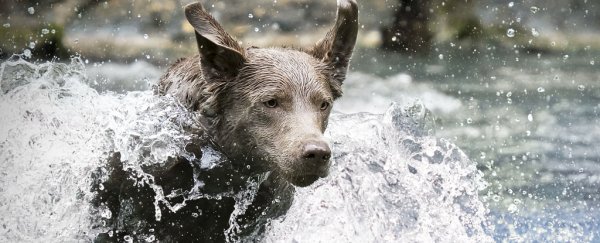Dogs might not be able to recognize themselves in a mirror, but that doesn't mean our pets don't have some level of self-awareness.
Recent research has shown dogs can recognize the unique smell of their own odor, sort of like looking in an 'olfactory mirror', and in 2021, a study found they might also have some awareness of their body as an obstacle.
Body awareness is the ability to think of your body as an explicit object in relation to other objects around you. It's considered one of the fundamental building blocks of self-representation.
In human children, this type of self-awareness has historically been tested by having a toddler hand over a blanket they are currently sitting on. If the kid can figure out that they have to get up and remove their body as an obstacle, they are henceforth declared 'body-aware'.
Usually, it takes infants until they are about 18 months or a year before they have the mental capacity to figure this out.
Adapting this test for canines, researchers have attempted to see whether these animals also possess such a level of body awareness.
Previously, a small study found that dogs have some idea of their body size and how that impacts their navigation in the world, but the 2021 paper is the first research to show recognition of the body as an obstacle in general.
The researchers found 32 dogs of various breeds and sizes who met the testing requirements, which involved the pets picking up a toy and bringing it to their owner. The catch was that the toy was connected to a mat on which the dogs were sitting.
In other words, to bring the toy to their owner, the dog first needed to get off the mat.
These results were then compared to what happens when the toy is unattached to anything at all or when the toy is connected to the ground.
"This way, when the dogs tried to pick the target up, this was again impossible, however, dogs did not feel a parallel lifting force under their feet," the authors write.
Without this tug beneath them, the dogs did not step off the mat as quickly. They rightly realized their position wasn't the problem. But when the dog did feel a tug on the mat below them, they were much quicker to step off and pick up the toy after. Still, it wasn't just this one sensation that was tipping the dogs off.
Even when the toy was connected to the ground and a researcher tugged the dogs' feet using a rope, the pets didn't jump off the mat as quickly. This suggests dogs can understand when a tug is made from their own efforts and when a tug is made that is not related to the challenge at hand.
In short, the pets in the study were able to differentiate between 'My body is the obstacle' and simply 'There is an obstacle.' They also know how to instinctively move their bodies to overcome barriers to success.
"We argue that dogs' response in the main test can be explained based on their body awareness and the understanding of the consequences of their own actions," the authors wrote.
Far more research will be needed to understand the continuum of self-awareness that exists in the animal kingdom, and not only in dogs. Very little research has been done on the awareness animals have of their body as an obstacle.
Elephants are one of the only other animals that have gone through similar 'body as an obstacle' tests. During one such study, researchers found Asian elephants stepped off the mat much quicker when doing so was necessary for their success in a task.
The results are similar to what has now been shown in dogs, but elephants can also recognize themselves in a mirror, unlike canines.
The mirror test is based on visual appearance, but the 'body as an obstacle' test is about one's own actions and the physical properties of our bodies as an extension of that. Elephants have both these types of self-recognition figured out. Dogs, it seems, may only have one.
"Although dogs did not pass the mirror mark test, we now have evidence that they can pass the body as an obstacle test," the researchers conclude.
"Our results support self-representation as an array of more or less connected cognitive skills, and the presence or lack of a particular building block may vary according to the species."
The study has been published in Scientific Reports.
A version of this article was first published in February 2021.
